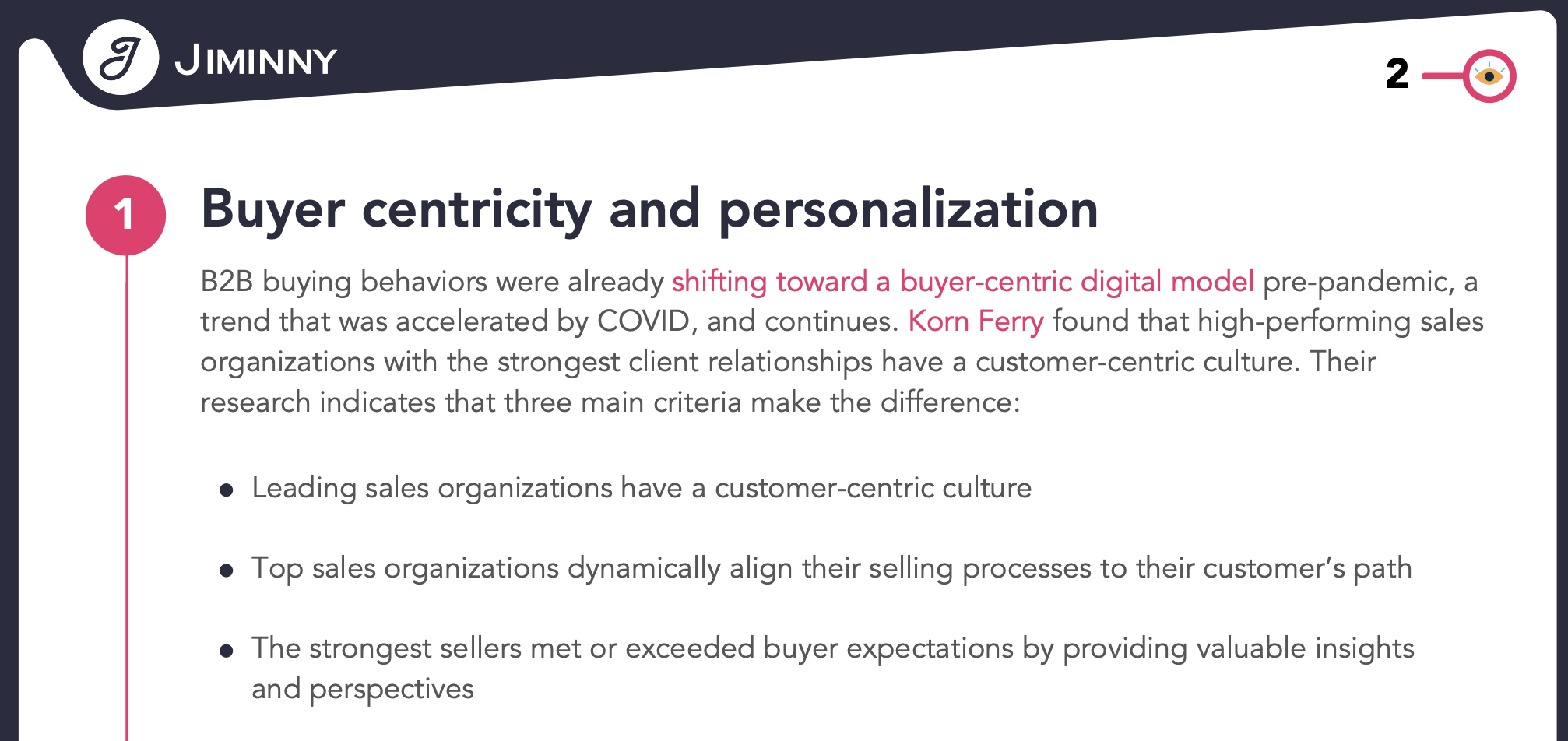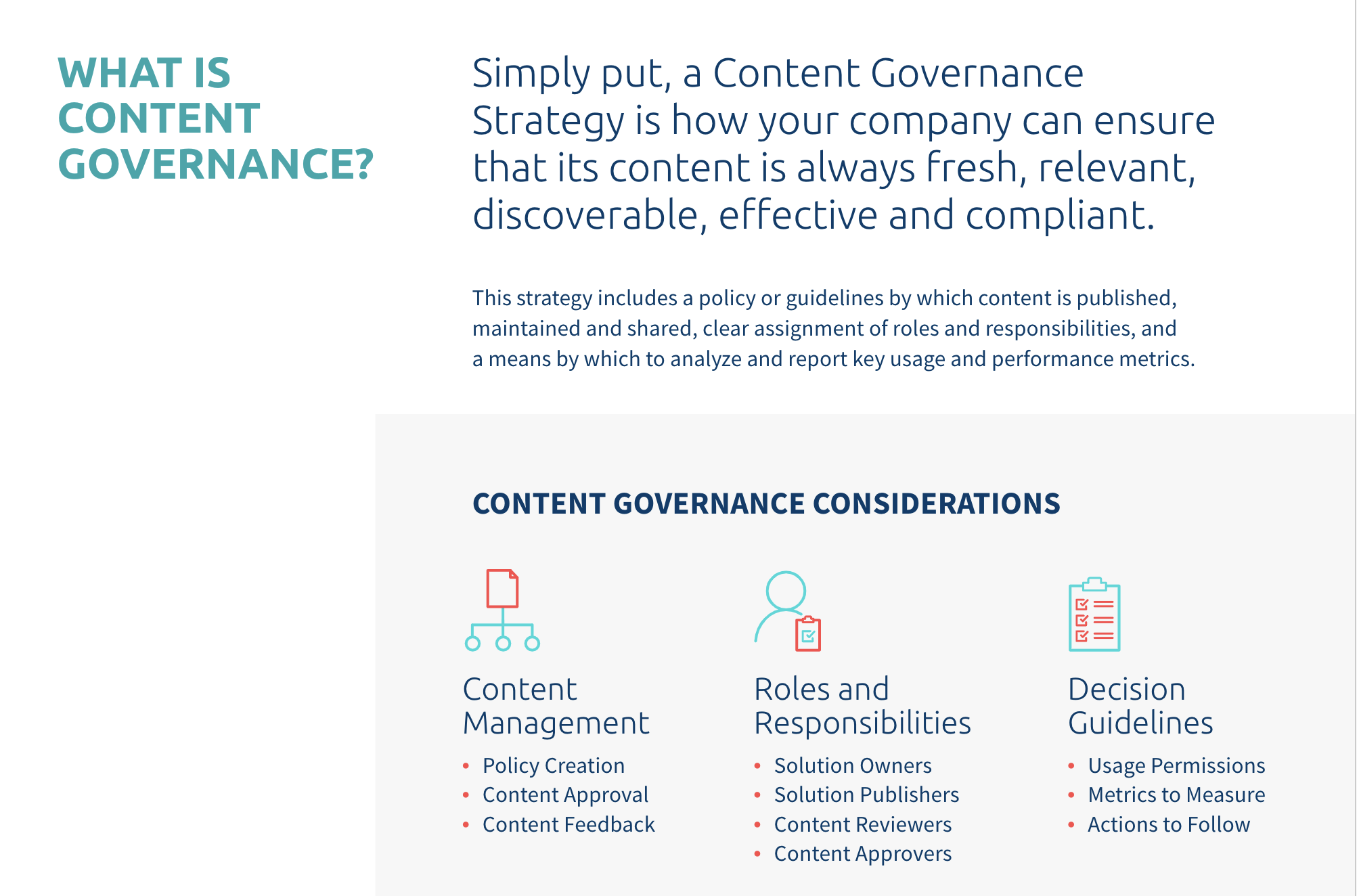Whenever I say the word whitepaper, I often get glazed-over looks, weird nodding motions, and get-me-out-of-here body language. And sure, a whitepaper isn't as glamorous as a data report or as relatable as a blog post, but don't knock it till you've tried it.
I've written several whitepapers (also known as special reports or research reports) over the years, and they're actually pretty interesting to research and write, especially if you love doing deep dives into topics.
And when done properly, whitepapers generate quality leads that will advance through the sales process. Here's everything you need to know about whitepapers.
What is a whitepaper?
A whitepaper is a sales and marketing document written as an authoritative report to educate and inform potential customers. It discusses, in-depth, a potential solution to the prospect's problem, or pain point, where your product or service is an obvious solution. By incorporating research, studies, surveys, and other data to support the presented information, your whitepaper answers your customers' questions while simultaneously nudging them to consider your business as a solution. It's a win-win.
Because whitepapers genuinely help your audience and position you as an authority, they're a really valuable lead generation tool: whitepapers are typically presented as gated content, meaning prospects have to complete a form (providing their contact information) to download the content.
With Zapier, you can automatically send the data you capture in your lead gen forms to your CRM, email marketing tool, or any other app you use. Learn more.
But remember: although a whitepaper is a marketing document, it's not a pitch or product presentation. It's designed to be a resource for ideal prospects at various stages of their buying journey.
Benefits of a whitepaper
A customer will read a whitepaper because it educates them on something they want to know more about. But in the process, whitepapers help potential customers learn more about your product, service, or solution and persuade them to take the next step in their buying journey.
Here are the primary benefits for your business:
It positions you as an authority in your industry, demonstrating that you understand your customers' problems and how to solve them.
It increases awareness of your solution to those problems.
It builds brand trust by helping prospects make an informed buying decision.
It gets you valuable contact details and insights for nurturing leads.
It serves as sales enablement content, helping your sales team close deals.
When should you use a whitepaper?
Let's say you have a coffee shop. Coffee is a product that speaks for itself—anyone walking by can smell what you're brewing and decide if it's enticing or not. But if your offering is less tangible and more knowledge-based, then you'll need a different way to draw in customers and display your expertise. Whitepapers are a great solution.
This is especially true if you sell something relatively complex or with a longer sales cycle. Just keep in mind that it's a trade-off: by gating the content, you're not getting the SEO value from it. You'll have fewer eyeballs on your content, but the people attached to those eyeballs will be much more likely to buy from you.
Whitepaper examples
Here are two whitepaper examples, to give you a sense of what they look like.
Whitepaper example: Jiminny
This whitepaper, published by Jiminny, is designed to attract leads that want to better understand what sales functions look like in a mostly virtual world. It cites studies and sales leaders to help inform the audience, and it only briefly mentions its conversational intelligence tool that can help sales teams perform better.

Whitepaper example: Highspot
This whitepaper, published by Highspot, is designed to attract B2B prospects that want to give their sales reps the right content at the right time, while avoiding inconsistent or off-brand messaging. As a sales enablement platform, Highspot is positioned to offer this type of education, and folks interested in it will likely be qualified leads for them.

Whitepaper vs. eBook vs. blog post: What's the difference?
You have a bunch of options for written content—a whitepaper is only one of them.
A blog post is lighter in tone, shorter in length, and never gated. While blog posts vary in length, they're generally shorter than eBooks or whitepapers—and they tend to be hyper-focused on a specific topic.
An eBook can also be light in tone, but it's longer and usually gated. It digs deeper into a topic or might present information on a broader collection of topics. It also often has a lot of visuals to support the text.
A whitepaper is often more authoritative in tone, is longer, and cites research from start to finish.
Each of these options can be used for various stages of the buying journey, and each can point to your product or service as a solution, but you'll be attracting different types of audiences depending on which one you choose. And, of course, you can (and depending on your industry, should!) be creating all three. You can even repurpose content from one to use in another.
The 3 main types of whitepaper
Once you've decided you need a whitepaper, you'll need to figure out which type of whitepaper you want to develop. You can map it to the stage of the customer journey you're targeting.
Numbered list whitepaper
This type of whitepaper presents a set of points about a specific topic of interest to your audience, often leaning heavily on industry trends.
Funnel stage: Awareness. This roundup style is often used to nurture prospects in the early stages of the customer journey—folks who are looking for general industry information and want to be better informed.
Example: Jiminny's research report, The Top Six Sales Trends of 2022.
Problem/solution whitepaper
This type of whitepaper recommends a new or better solution for a challenging business or technical problem.
Funnel stage: Consideration. This type of whitepaper is often used to attract and educate prospects in the middle stages of the buying journey: they know they have a problem, and they're researching ways to meet their challenges and goals.
Example: Sales Readiness Group's whitepaper, Maximize the Effectiveness of Sales Training.
Backgrounder
This type of whitepaper explains the technical features of a product or service and its related benefits.
Funnel stage: Decision. This is useful for prospects comparing a shortlist of solutions near the end of the customer journey: they want more information about your specific product or service.
Example: Highspot's whitepaper, Highspot Security Overview: How we protect your data.
There are also loads of business-savvy chimeras that combine aspects of each of these types. Don't feel pigeon-holed, but use these three types as guidance for how to think about developing your whitepaper.
How to write a whitepaper
Now it's time to sit down and write the thing. But how exactly do you do that? First, keep in mind that writing a whitepaper takes longer and is much more intense than writing a blog post. You're not going to bang it out in one sitting, so before you begin the process, it's best to have a roadmap to keep you on track.
1. Select a topic and style
Choosing the right topic for your whitepaper directly influences the results. If you select a topic of serious interest to your ideal audience, you'll generate lots of leads and insights. Otherwise, you'll have wasted your time on a long piece of content.
Develop or use an existing customer profile to help identify your audience's top needs, challenges, and goals. Then, determine where you need content along the customer journey: awareness, consideration, or decision.
Ask yourself:
Do I need something to explain how my product solves a problem for a specific audience to attract new leads?
Do I need a well-researched report to nurture prospects until they're ready to buy?
Is there a complex feature that prospects need to understand thoroughly before making their final buying decision?
These questions will help you identify which type of whitepaper to write and what topic to write about.
2. Do your research
To write about a topic well, you'll need to understand it through and through. Complete thorough research before diving into any actual writing: read other papers on the topic, interview subject matter experts, or conduct a survey. Search for data, surveys, and research studies from authoritative industry sources to help build your argument and prove your whitepaper's premise.
If your whitepaper reads like a blog post, with minimal citations and a lack of authoritative sources, readers won't see you as a valuable source of information.
3. Create an outline
An outline may seem tedious—and I'm not going to force you to make one for every short blog post you write—but when it comes to a whitepaper, it's necessary. It's easy to ramble when you're writing long-form content, and an outline prevents you from getting off-topic. You'll be glad you have one after you write a few pages and think, "Wait…where am I going with this?"
Here's a standard whitepaper format:
Introduction
Various sections (and subsections) throughout the body, guided by your research
Conclusion
Somewhere in your whitepaper (usually at the beginning or end), you'll also want a section about your company. How prominent this description is will depend on the type of whitepaper you're writing, but you want people to know who's providing this valuable resource.
Also in your outline, indicate where you'll want graphics and what you think those graphics should demonstrate or represent. This will help you kick off the design aspect earlier, so there isn't a design bottleneck once you've completed the whitepaper.
4. Get feedback
Always run your outline by other stakeholders before moving forward. (If you have a sales or customer support team, they're great resources because they have their finger on the pulse of customer pain points.) Now's your chance to get everyone on the same page, brainstorm any gaps in the content, or see a different perspective on a given topic.
If you do this before writing, it'll save you a lot of time and effort down the line.
5. Write your whitepaper
With that feedback in hand, flesh out your outline and write the body of your whitepaper report. Dig into that research, and give your readers keen insights and valuable takeaways. A few specific notes:
Add subheadings to break up large sections for readers who prefer to skim—they'll also make the document easier to read for everyone.
Add comments to note when something should be placed in a callout box or otherwise highlighted in the final version.
Indicate where different visuals will be placed.
Cite your sources. I know this goes without saying, but it's a non-negotiable.
Once you've finished the body copy, write your introduction, executive summary, and conclusion. Readers get the gist of the report by reading these sections before deciding if reading the whole whitepaper is worthwhile.
6. Edit and refine
Let your whitepaper draft sit for a day or more, and then come back to it. Review the document with a fresh outlook, and try reading it aloud to make sure it flows properly from section to section—do your best self-editing.
Once you have what you think is a final draft of your whitepaper, have a trusted colleague or an editor do a final proofread. (Or they might give you bigger picture feedback, in which case, back to the drawing board!)
7. Add formatting, graphics, and design
You've done it—you have a final draft. Now, make it visually pleasing. Work with a designer to add those graphs, charts, or illustrations to help your audience literally see your points. Lean into aesthetics and dress up your whitepaper with a dynamic layout and design aspects. Just be sure your design choices aren't interfering with readability.
8. Create a landing page with a lead gen form
You're ready to roll out your whitepaper. Create a landing page or pop-up where your audience can trade contact information for your content. If you have an existing resource library on your website, put it there; otherwise, a one-off page will do the trick. (Here are some tips on crafting solid lead gen forms and a case for using micro conversions.)

And remember, the landing page is only one way to get people to download your whitepaper. You should also get your sales team involved, and advise them to share your whitepaper with prospects they've been nurturing. Use your whitepaper cross-functionally, and reap the benefits of your well-researched, well-crafted document.









